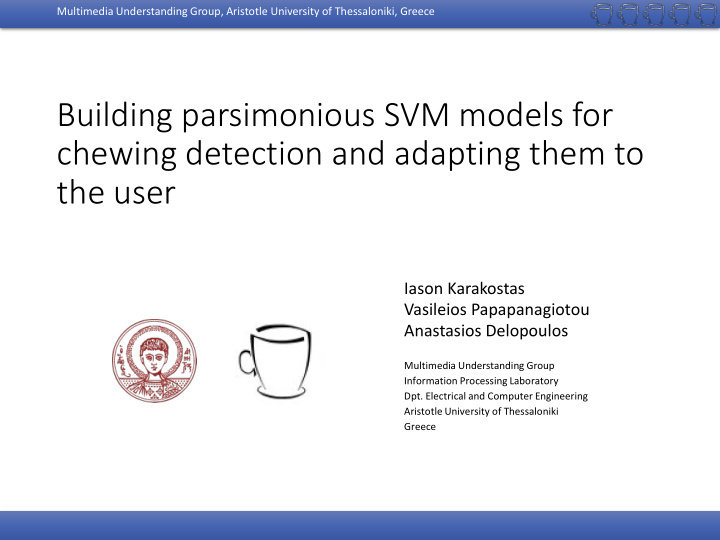



Multimedia Understanding Group, Aristotle University of Thessaloniki, Greece Building parsimonious SVM models for chewing detection and adapting them to the user Iason Karakostas Vasileios Papapanagiotou Anastasios Delopoulos Multimedia Understanding Group Information Processing Laboratory Dpt. Electrical and Computer Engineering Aristotle University of Thessaloniki Greece
Multimedia Understanding Group, Aristotle University of Thessaloniki, Greece Introduction • Automatically monitoring eating activity has received significant attention in the research community • Most of the proposed systems require proprietary/specialized sensors We propose • A chewing detection system that captures audio from a commercial bone conduction microphone • A method to build efficient and effective SVM models • A method to adapt the SVM model to user requiring minimal user feedback Building parsimonious SVM models for chewing detection and adapting them to the user
Multimedia Understanding Group, Aristotle University of Thessaloniki, Greece Chewing detection hardware Commercial bone-conduction Android smart-phone microphone Building parsimonious SVM models for chewing detection and adapting them to the user
Multimedia Understanding Group, Aristotle University of Thessaloniki, Greece Audio signal pre-processing and feature extraction • • Sampling at 4 kHz Overlapping windows • • High pass FIR cut-off frequency step = 160 samples, • at 20 Hz time domain features windows • Hamming filter of 3.72 sec (length = 400 samples) • spectral features windows (length = 800 samples) Voice A single chew Building parsimonious SVM models for chewing detection and adapting them to the user
Multimedia Understanding Group, Aristotle University of Thessaloniki, Greece Extracted features • 16 features • 7 time domain and 9 spectral features • Fractal dimension and log of variance are quite discriminative individually 0.8 0.4 chewing chewing non-chewing non-chewing 0.6 0.3 0.4 0.2 0.2 0.1 0 0 1.2 1.4 1.6 1.8 2 -16 -12 -8 -4 0 Fractal Dimension Log of Variance Building parsimonious SVM models for chewing detection and adapting them to the user
Multimedia Understanding Group, Aristotle University of Thessaloniki, Greece Classification and Active Learning • Classification of feature vectors using the SVM classifier • Active Learning • A method of improving a classifier’s effectiveness by enhancing the training set in “rounds” • Apply model on pool of feature vectors • Select feature vectors and request feedback (correct label) • Active learning is used for: • Parsimonious Active Learning Training (PALT) • Inter-Active Learning Adaptation (IALA) Building parsimonious SVM models for chewing detection and adapting them to the user
Multimedia Understanding Group, Aristotle University of Thessaloniki, Greece Parsimonious Active Learning Training (PALT) A method to create SVM models with • much fewer support vectors • without sacrificing much of the model’s discriminative power Building parsimonious SVM models for chewing detection and adapting them to the user
Multimedia Understanding Group, Aristotle University of Thessaloniki, Greece Inter-Active Learning Adaptation (IALA) • Adaptation of a pre-trained SVM model to a single user based on inter-active feedback requests for ambiguous time intervals • Can be applied both on directly trained models and on PALT models • Based on time and SVM score thresholds Building parsimonious SVM models for chewing detection and adapting them to the user
Multimedia Understanding Group, Aristotle University of Thessaloniki, Greece Dataset • Recordings from 8 subjects using Invisio M3h microphone • Recording protocol • 7 food types • Non-chewing activities • Both silent and noisy setups • Ground truth labels assigned based on time-stamps and visual inspection of the captured signals • Total duration: 90 minutes • Prior probability: 0.45 for chewing class Building parsimonious SVM models for chewing detection and adapting them to the user
Multimedia Understanding Group, Aristotle University of Thessaloniki, Greece Experimental evaluation • Cross-Validation (CV) and Leave-One-Subject-Out (LOSO) experiment setups • Baseline and PALT performance comparison • Recordings from 8 subjects • IALA method evaluation using both directly trained and PALT as base models • Recordings from 6 subjects that recorded the protocol twice Building parsimonious SVM models for chewing detection and adapting them to the user
Multimedia Understanding Group, Aristotle University of Thessaloniki, Greece PALT Evaluation Results k-fold Cross-Validation (k=14) initial train set has 40 feature vectors Precision Recall F1 score Accuracy SVs CV baseline 0.89 0.89 0.89 0.90 33552 CV PALT@100 0.83 0.89 0.86 0.87 232 CV PALT@800 0.85 0.90 0.87 0.88 1633 LOSO evaluation Precision Recall F1 score Accuracy SVs LOSO baseline 0.84 0.81 0.81 0.83 31152 LOSO PALT@100 0.82 0.79 0.79 0.83 233 LOSO PALT@800 0.81 0.82 0.8 0.83 1632 Building parsimonious SVM models for chewing detection and adapting them to the user
Multimedia Understanding Group, Aristotle University of Thessaloniki, Greece IALA Evaluation Results Precision Recall F1 score Accuracy SVs LOSO baseline 0.84 0.82 0.81 0.82 25043 LOSO PALT 0.87 0.66 0.72 0.82 1633 LOSO base + IALA 0.84 0.83 0.82 0.83 25038 LOSO PALT + IALA 0.88 0.80 0.83 0.85 1652 LOSO evaluation on 6 subjects that recorded the protocol twice Building parsimonious SVM models for chewing detection and adapting them to the user
Multimedia Understanding Group, Aristotle University of Thessaloniki, Greece Conclusions • We use active learning techniques for two tasks • Create and deploy classification models with fewer SVs that require reduced computational resources • Per-user adaptation of the deployed model, requiring minimal user feedback, and leading to increased accuracy • User adaptation with IALA has better performance when used with a PALT base model • Validation on an experimental dataset recorded in lab conditions shows inter- subject accuracy of 0.85 using user-adapted models and parsimonious initial SVM models • Future work: Evaluation of the proposed system on a larger dataset under free- living conditions Building parsimonious SVM models for chewing detection and adapting them to the user
Multimedia Understanding Group, Aristotle University of Thessaloniki, Greece Thank you Building parsimonious SVM models for chewing detection and adapting them to the user
Recommend
More recommend